Dice theme by Gabriel Seador
Download: Dice.p3t
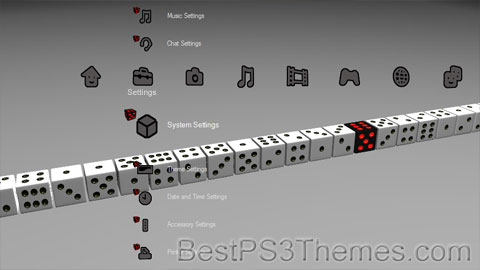
(2 backgrounds)
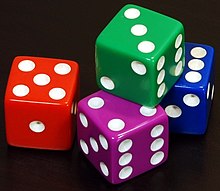
Dice (sg.: die or dice)[1] are small, throwable objects with marked sides that can rest in multiple positions. They are used for generating random values, commonly as part of tabletop games, including dice games, board games, role-playing games, and games of chance.
A traditional die is a cube with each of its six faces marked with a different number of dots (pips) from one to six. When thrown or rolled, the die comes to rest showing a random integer from one to six on its upper surface, with each value being equally likely. Dice may also have polyhedral or irregular shapes, may have faces marked with numerals or symbols instead of pips and may have their numbers carved out from the material of the dice instead of marked on it. Loaded dice are specifically designed or modified to favor some results over others for cheating or entertainment.
History[edit]
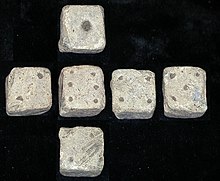
Dice have been used since before recorded history, and it is uncertain where they originated. It is theorized that dice developed from the practice of fortune-telling with the talus of hoofed animals, colloquially known as knucklebones.[2] The Egyptian game of senet (played before 3000 BCE and up to the 2nd century CE) was played with flat two-sided throwsticks which indicated the number of squares a player could move, and thus functioned as a form of dice.[3] Perhaps the oldest known dice were excavated as part of a backgammon-like game set at the Burnt City, an archeological site in south-eastern Iran, estimated to be from between 2800 and 2500 BCE.[4][5] Bone dice from Skara Brae, Scotland have been dated to 3100–2400 BCE.[6] Excavations from graves at Mohenjo-daro, an Indus Valley civilization settlement, unearthed terracotta dice dating to 2500–1900 BCE,[7] including at least one die whose opposite sides all add up to seven, as in modern dice.[8]
Games involving dice are mentioned in the ancient Indian Rigveda, Atharvaveda, Mahabharata and Buddhist games list.[9] There are several biblical references to "casting lots" (Hebrew: יפילו גורל yappîlū ḡōrāl), as in Psalm 22, indicating that dicing (or a related activity) was commonplace when the psalm was composed. Knucklebones was a game of skill played in ancient Greece; a derivative form had the four sides of bones receive different values like modern dice.[10]

Although gambling was illegal, many Romans were passionate gamblers who enjoyed dicing, which was known as aleam ludere ("to play at dice"). There were two sizes of Roman dice. Tali were large dice inscribed with one, three, four, and six on four sides. Tesserae were smaller dice with sides numbered from one to six.[11] Twenty-sided dice date back to the 2nd century CE[12] and from Ptolemaic Egypt as early as the 2nd century BCE.[13]
Dominoes and playing cards originated in China as developments from dice.[14] The transition from dice to playing cards occurred in China around the Tang dynasty (618–907 CE), and coincides with the technological transition from rolls of manuscripts to block printed books.[15] In Japan, dice were used to play a popular game called sugoroku. There are two types of sugoroku. Ban-sugoroku is similar to backgammon and dates to the Heian period (794–1185 CE), while e-sugoroku is a racing game.[16]
-
Knucklebones die, made of soapstone
-
Roman die
-
A collection of historical dice from various regions of Asia
-
Chinese dice from Late Yuan Dynasty to early Qing Dynasty in Jiangyin Museum, China.
Use[edit]
Dice are thrown onto a surface either from the hand or from a container designed for this (such as a cup, tray, or tower). The face (or corner, in cases such as tetrahedral dice, or edge, for odd-numbered long dice) of the die that is uppermost when it comes to rest provides the value of the throw.
The result of a die roll is determined by the way it is thrown, according to the laws of classical mechanics (although luck is often credited for the results of a roll). A die roll is made random by uncertainty in minor factors such as tiny movements in the thrower's hand; they are thus a crude form of hardware random number generator.
One typical contemporary dice game is craps, where two dice are thrown simultaneously and wagers are made on the total value of the two dice. Dice are frequently used to introduce randomness into board games, where they are often used to decide the distance through which a piece will move along the board (as in backgammon and Monopoly).
Construction[edit]
Arrangement[edit]
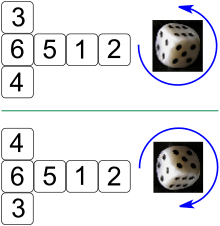
Common dice are small cubes, most often 1.6 cm (0.63 in) across, whose faces are numbered from one to six, usually by patterns of round dots called pips. (While the use of Arabic numerals is occasionally seen, such dice are less common.)
Opposite sides of a modern die traditionally add up to seven, requiring the 1, 2, and 3 faces to share a vertex.[17] The faces of a die may be placed clockwise or counterclockwise about this vertex. If the 1, 2, and 3 faces run counterclockwise, the die is called "right-handed". If those faces run clockwise, the die is called "left-handed". Western dice are normally right-handed, and Chinese dice are normally left-handed.[18]
The pips on standard six-sided dice are arranged in specific patterns as shown. Asian style dice bear similar patterns to Western ones, but the pips are closer to the center of the face; in addition, the pips are differently sized on Asian style dice, and the pips are colored red on the 1 and 4 sides. Red fours may be of Indian origin.[18][19]
-
Typical facets showing the more compact pip arrangement of an Asian-style die (top) vs. a Western-style die (bottom)
Manufacturing[edit]
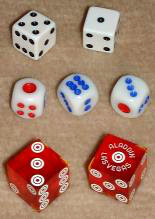
Non-precision dice are manufactured via the plastic injection molding process, often made of polymethyl methacrylate (PMMA). The pips or numbers on the die are a part of the mold. Different pigments can be added to the dice to make them opaque or transparent, or multiple pigments may be added to make the dice speckled or marbled.[20]
The coloring for numbering is achieved by submerging the die entirely in paint, which is allowed to dry. The die is then polished via a tumble finishing process similar to rock polishing. The abrasive agent scrapes off all of the paint except for the indents of the numbering. A finer abrasive is then used to polish the die. This process also produces the smoother, rounded edges on the dice.
Precision casino dice may have a polished or sand finish, making them transparent or translucent respectively. Casino dice have their pips drilled, then filled flush with a paint of the same density as the material used for the dice, such that the center of gravity of the dice is as close to the geometric center as possible. This mitigates concerns that the pips will cause a small bias.[21] All such dice are stamped with a serial number to prevent potential cheaters from substituting a die. Precision backgammon dice are made the same way; they tend to be slightly smaller and have rounded corners and edges, to allow better movement inside the dice cup and stop forceful rolls from damaging the playing surface.
Etymology and terms[edit]
The word die comes from Old French dé; from Latin datum "something which is given or played".[22]
While the terms ace, deuce, trey, cater, cinque and sice are generally obsolete, with the names of the numbers preferred, they are still used by some professional gamblers to designate different sides of the dice. Ace is from the Latin as, meaning "a unit";[23] the others are 2 to 6 in Old French.[24]
When rolling two dice, certain combinations have slang names. The term snake eyes is a roll of one pip on each die. The Online Etymology Dictionary traces use of the term as far back as 1919.[25] The US term boxcars, also known as midnight, is a roll of six pips on each die. The pair of six pips resembles a pair of boxcars on a freight train. Many rolls have names in the game of craps.
Unicode representation[edit]
| Symbol | ⚀ | ⚁ | ⚂ | ⚃ | ⚄ | ⚅ |
One Reply to “Dice”Comments are closed. |
|---|


![Twenty-sided serpentinite die from Ptolemaic Egypt[13]](http://upload.wikimedia.org/wikipedia/commons/thumb/9/9b/Twenty-sided_die_%28icosahedron%29_with_faces_inscribed_with_Greek_letters_MET_10.130.1158_001.jpg/168px-Twenty-sided_die_%28icosahedron%29_with_faces_inscribed_with_Greek_letters_MET_10.130.1158_001.jpg)
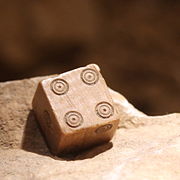
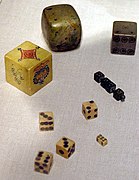


Roll, Play, Win